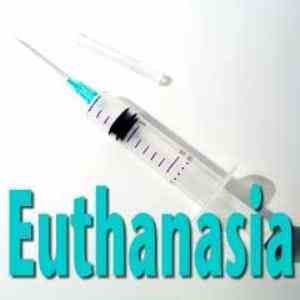
The word euthanasia itself appear to be controversial. Manypeople argue whether euthanasia should be legalized in China. Asfar as I know, many other counties besides China have been usingeuthanasia as a punishment or medical treatment. This wide usagecreates the tendency that euthanasia should be legalized so morepeople can use it.
First of all, the word euthanasia means to die quietyly andeasily. Practicing euthanasia can therefore benefit both patientsand their family. I believe that practicing euthanasia on a patientwith a hopeless case is humanity--it can reduce the patient’s painand his or her family’s burden. But if people abuse euthanasia whenit is legalized, it can harm people lives.
Moreover, euthanasia is widely use as a punishment. Manycriminals commit crimes out of their will; they also have humanright. Euthanasia can be a relief to the criminal.We shouldlegalize it to make our society moreharmonious.
To sum up, every issue have two sides, so it depends how we seeit. This issue on euthanasia, I suggest that China legalize it todraw up laws that make it into a model.
Europe: Charlemagne
The great euthanasia debate
安乐死的巨大争论
Apr 2nd 2009
From The Economist print edition
How attitudes to mercy killings differ around Europe
欧洲国家对安乐死的态度有多不同?
TWO European countries, Britain and Belgium, have had cause inrecent weeks to ponder the same ethical question: what happens whendoctors decide a patient has no chance of a bearable life? InBritain headlines reported the grief of parents whose wishes wereoverruled by the courts, allowing doctors to turn off theventilators keeping their son alive. Shortly afterwards a new studyreported that active euthanasia—in which not only is medical carewithdrawn, but drugs are used to shorten life—is opposed bytwo-thirds of British doctors.
最近几周以来,两个欧洲国家:英国,比利时有缘由来思考同一个伦理问题:当医生判定病人已经无法苟活时应该怎么办?英国以头条报道了一对悲痛的夫妇,他们希望法院允许医生撤掉维持他们儿子生命的呼吸机,但是他们的要求被法院驳回了。不久以后,一个新的研究报告称三分之二的英国医生反对主动安乐死(不只是撤掉医疗护理,而且用药物加速死亡)。
A similar debate has broken out in Belgium, another Europeancountry that has moved in a broadly secular, permissive directionover the past few decades. But this one was very different. Buriedon inside pages, small newspaper stories reported a survey ofpaediatric intensive-care nurses. It emerged that they hadwitnessed two dozen infants and children being given lethal drugsto speed their deaths. That amounts to involuntary euthanasia,which is illegal (though Belgium, like the Netherlands, haslegalised euthanasia for consenting adults). Asked if the lawshould be changed to allow the ending of minors’ lives, 89% ofnurses in the Belgian study said yes.
另一个在过去的几十年里已经开化的欧洲国家,比利时,也爆发了类似的争论。但是这个国家不一样。在小报内页报道了对儿科重症监护病房的护士的调查。调查显示这些护士目睹了24个婴幼儿被给予致命药物来加速他们的死亡。这等同于非法的“非自愿安乐死”(虽然比利时和荷兰一样,成人的自愿安乐死已经合法化)。比利时的研究显示,当被问到是否应该修改法律来允许未成年人的安乐死时,89%的护士表示赞同。
This was not a rogue result. In 2005 academics investigated all292 children who died before their first birthday in a given yearin Flanders, the Dutch-speaking bit of Belgium. In half the cases,doctors had taken an “end-of-life decision”, a term that takes inthree distinct practices. Most often, doctors withdrew or withheldtreatment keeping infants alive, which is quite a common practice.In 40 cases, painkillers such as morphine were used to alleviatesuffering, but at high doses likely to hasten death: a legal greyarea. In 17 cases lethal drugs or doses were illegally given to endlife. Similar practices were revealed by a study in theNetherlands; that led to the appointment of a committee to reviewcases where a baby’s suffering seems impossible to relieve,suggesting that a swift death might be merciful.
这不是无稽之谈。在2005,有学者调查了Flanders(比利时的荷语区)未满周岁就夭亡的292名幼儿。在一半的案例中医生采取了“生命终结决定”,这个术语包含3个不同的手段。最常见的手段是,医生撤回或拒绝给予用来维持婴幼儿生命的治疗。在其中的40个案例当中,吗啡等止痛剂被用来缓解疼痛,但是过量可能加速死亡:一个法律的灰色区域。在其中的17个案例中,致命药物或制剂非法地用于终结生命。荷兰的研究披露了类似的行为;这促成了一个委员会来检查婴儿的痛苦无法缓解的案例,暗示快速的死亡是人道的。
Even to set up such a committee would be controversial in mostof Europe, especially where church leaders retain political clout.In Britain debate on euthanasia revolves around gravely ill adultswho consciously want to die. Even in such secular, permissivecountries as Sweden, doctors tell surveys they oppose euthanasia bylarge margins. What explains these differences?
即使在欧洲的大部分国家,成立这样一个委员会都是有争议的。特别是在教会领袖保有政治影响的国家,在英国,有关安乐死的争论围绕在那些自愿死亡的重病成年人。即使在瑞典这样一个开化的国家,大部分的医生告诉调查者他们反对安乐死。这些差异该怎么解释呢?
Religious faith is important, but can be trumped. A 2006 studyfound that in Italy and Poland, practising Catholics were morehostile to euthanasia than their less devout compatriots. But inFrance, the Netherlands, Belgium and Scandinavia, believers andtheir secular neighbours hold similar views. Memories of Naziprogrammes to murder unwanted citizens under the label of“euthanasia” make Germans cautious, regardless of religion. Theauthor of the recent British studies, Clive Seale of LondonUniversity, notes another wrinkle: British doctors are morereligious than the population at large, with half callingthemselves somewhat, very or extremely religious, as opposed to athird of ordinary Britons. (Not all those devout doctors areChristians: the National Health Service employs many Asians andBritish Asians).
宗教信仰很重要,但是没重要到可以压倒一切。一项2006的研究发现,在意大利和波兰,职业的天主教徒比他们较不虔诚的同胞更敌视安乐死。但是在法国,荷兰,比利时和斯堪的纳维亚半岛,信仰者和他们开化的邻居持有相同的观点。纳粹以安乐死的名义谋杀无用的平民的计划的记忆使得德国人小心翼翼,无视宗教。近来的英国研究的作者,伦敦大学的CliveSeale,注意到另一个有用的信息:一般来说英国医生比普通平民更笃信宗教,相比三分之一的普通英国人,半数医生自认为稍微,非常或极端笃信宗教。(并不是所有的笃信宗教的医生都是基督徒:国民医疗服务制度雇佣了许多亚洲人和亚裔英国人)。
National character matters too. In the Netherlands, euthanasiais mostly carried out by family doctors, who know their patientswell. The Dutch are an outspoken, demanding bunch, who expectstraight answers, says Luc Deliens, a Belgian academic. Things aredifferent in southern Europe, where doctor-patient relationshipsare more hierarchical. The Dutch, a seafaring nation of traders,have also long imported new and foreign opinions. They are used toresolving conflicting principles, says Dick Willems, a Dutch doctorand ethicist. There has never been “one very strong common ideaabout what is allowed”.
这和民族性也有关系。在荷兰,安乐死大部分由熟悉他们的病人的家庭医生执行。比利时学者LucDeliens说,荷兰人是直率的,苛刻的,他们期待直接的回答。欧洲南部又是另一番景象,在那里医患关系更分等级。荷兰人,开展海上贸易的民族,也渴望“进口”新的和外国的意识形态。荷兰的医生,伦理学家DickWillems说,他们惯于解决相冲突的原则。“对于什么是可行的”,他们从来没有“一个非常强烈的共同的想法”。
Economics plays a role, he adds. In America a long terminalillness can leave people deep in debt: that makes ethicists fearthat euthanasia might be requested for financial reasons. In Dutchhospitals, compulsory insurance covers even the most expensivetreatments, lessening such fears.
经济状况也很关键,他补充道。在美国,长期的晚期疾病能使人债台高筑:因此,伦理学家害怕人们可能会以财政为原因请求安乐死。在荷兰的医院,强制保险甚至覆盖了最昂贵的治疗手段,这减轻了伦理学家的担心。
When to pull the plug
争论什么时候终止?
Arguably, some countries are in denial. In only a few countrieshave there been serious attempts to measure the incidence ofeuthanasia. Academics found it existed in every country studied.London University studies estimate that one in 500 deaths inBritain involve voluntary euthanasia, and one in 300 involuntaryeuthanasia. That amounts to 3,000 deaths a year, outside any legalframework. British numbers are “disturbing” and cry out forregulation, says Mr Deliens. Britain also has a higher than averageincidence of “terminal sedation”, where patients are keptunconscious until they die. Critics call this “sloweuthanasia”.
有争议的是,有些国家不愿相信安乐死在其境内发生。只在一些国家有记录安乐死发生率的认真尝试。学者发现安乐死的确有计划的存在于每个国家。伦敦大学研究估计,在英国,每500个死亡者中有一个与自愿安乐死有关,每300个死亡者中有一个与非自愿安乐死有关。每年共计有3,000个死亡事件游离于法律框架之外。MrDeliens说,英国人安乐死的数目是“烦扰的”,而且急需管理。英国“临终镇静”的发生率高于平均水平,这让病人保持无意识状态直到死亡,批评家称为“慢性安乐死”。
Some worry that legal euthanasia creates a slippery slopetowards state-sponsored killing. Legalisation has not madeeuthanasia more common, Dutch experts insist: the main effect is toimprove communication between doctors, patients and families. Yetnot all legal grey areas can be resolved. Take the recent cases inBelgium, mostly of newborns whose lives were ended with lethaldrugs. A typical case might involve an irreversibly brain-damagednewborn taken off artificial respiration who, instead of dying asexpected, lingers on, suffering terribly. In such cases, somedoctors feel obliged to hasten death. A law formalising rules forsuch cases would be a mistake, suggests Mr Willems. Some decisionsshould remain morally and personally difficult.
有人担心安乐死合法化引起人口灾难性的急剧下滑,是国家赞助的谋杀。荷兰专家坚持宣称:合法化没有让安乐死变得更普遍,安乐死合法化的主要作用是改善医生,病人及其家人之间的交流。但不是所有的法律灰色区域都能得到解决。就拿比利时最近的案例来说,大部分的新生儿的生命是由致命药物来终结的。一个典型的案例是关于一个不可逆的脑损伤新生儿撤掉了人工呼吸机,不是如预期的死亡,而是慢慢的,在极其痛苦中死去。在这样的案例当中,有些医生认为有义务加速死亡。MrWillems暗示,为这样的案例颁布一条法律成文条例将是一个错误。有些决定在精神上,就个人而言,仍然很困难。
The honesty of the Belgian and Dutch debate can feel prettybrutal. But whatever one’s views of euthanasia, openness is surelyto be applauded. The phenomenon is only now being studied properly.And when Europeans know, they will need to decide what they reallythink.
比利时和荷兰的直率的争论,让人感到相当无情。但是无论什么关于安乐死的看法,宽容都是值得赞许的。现在这个现象只是在适当的研究当中。当欧洲人了解安乐死的时候,他们将必须决定他们真正想要的是什么。
Country firstly legalized euthanasia
In April 2002, the Netherlands became the first country in theworld to legalize euthanasia. If a physician in the Netherlandsfollows the strict legal requirements for committing voluntaryeuthanasia or assisted suicide, the doctor will not beprosecuted.
The basics requirements are as follows:
The patient must have already been in the doctor's care for aperiod of time.
The patient's suffering is unbearable, and she or he has no hopeof recovery.
The patient makes a deliberate and voluntary request that she orhe has discussed thoroughly with the doctor.
The doctor consults a colleague who agrees that these criteriahave been met.
Belgium became the second country to legalize euthanasia inSeptember 2002. The Belgian law also lays out specific requirementsfor the doctor and patient, similar to the Dutch law.
But euthanasia is only one option available to terminally illpatients. Voluntary euthanasia means a person ends his or her lifethrough lethal injection administered by a doctor. Assisted suicideis considered to be death by oral ingestion of lethal drugs,usually prescribed by a doctor. Passive euthanasia is whenlife-support systems are disconnected from a terminally illpatient.
Switzerland allows suicide assisted by doctors and those withoutmedical training, but euthanasia is not legal in the country. Since1937, the Swiss criminal code has stated that suicide is not acrime, and it may be assisted for altruistic reasons. It's only acrime if someone assists the suicide out of negative motivation orfor financial gain.
The U.S. state of Oregon enacted a physician-assisted suicidelaw in November 1994. This allows doctors to prescribe a lethaldose of medication to terminally ill patients who meet certainrequirements, including state residency. The U.S. government hastried to challenge this law but has been unsuccessful so far.
Non-active euthanasia, or assisted suicide, is legal in three USstates;
Oregon
Washington
Montana
New Hampshire is currently considering a bill on assistedsuicide
Active euthanasia, commonly referred simply as euthanasia, isonly legal in:
the Netherlands
Belgium
Assisted suicide is also legal in:
Albania
Luxembourg
Switzerland does not punish doctors who perform euthanasia.
It was legal in the Northern Territory of Australia between theyears of 1995-1997, when the Territory's law was overruled by thecentral Parliament of Australia, which then outlawed euthanasia andrevoked the Territory's self-governing rights concerning matters ofeuthanasia. A bill is currently in the Australian Parliament which,if passed, would restore the Northern Territory's self-governancein that area. Japan is currently the only country that has no lawcriminalizing euthanasia, although legislation is being consideredwhich would spell out the country's legal view of the subjectexplicitly.
Euthanasia and the law
Map of the legality of euthanasia[neutrality disputed. Effortsto change government policies on euthanasia in the 20th centuryhave met limited success in Western countries. Country policies aredescribed below in alphabetical order, followed by the exceptionalcase of the Netherlands. Euthanasia policies have also beendeveloped by a variety of NGOs, most notably medical associationsand advocacy organizations.
Albania
Euthanasia was legalized in Albania in 1999, it was stated thatany form of voluntary euthanasia was legal under the rights of theterminally ill act of 1995. Passive euthanasia is considered legalshould three or more family members consent to the decision.Albania's euthanasia policy has been controversial among lifegroups and the Catholic Church, but due to other more prominentcountries also legalizing forms of euthanasia, it has met a morerelaxed world attitude to the matter.
Australia
Euthanasia was legalized in Australia's Northern Territory, bythe Rights of the Terminally Ill Act 1995. Soon after, the law wasvoided by an amendment by the Commonwealth to the NorthernTerritory (Self-Government) Act 1978.[1] The powers of the NorthernTerritory legislature, unlike those of the State legislatures, arenot guaranteed by the Australian constitution. However, before theCommonwealth government made this amendment, three people hadalready practiced legal voluntary euthanasia (PAS), aided by DrPhilip Nitschke. The first person was a carpenter, Bob Dent, whodied on 22 September 1996.
Although it is a crime in most Australian states to assist ineuthanasia, prosecutions have been rare. In 2002, relatives andfriends who provided moral support to an elderly woman whocommitted suicide were extensively investigated by police, but nocharges were laid. The Commonwealth government subsequently triedto hinder euthanasia with the passage of the Criminal CodeAmendment (Suicide Related Materials Offences) Bill of 2004. InTasmania in 2005 a nurse was convicted of assisting in the death ofher elderly mother and father who were both suffering fromillnesses. She was sentenced to two and a half years in jail butthe judge later suspended the conviction because he believed thecommunity did not want the woman put behind bars. This sparkeddebate about decriminalizing euthanasia.Decriminalisation ofEuthanasia in Australia is supported by the Liberty& Democracy Party as well as the AustralianGreens.
Also, very recently in Australia, an assisted euthanasia casehas arisen about the suspected issuing of the Euthanasia drugNembutal imported from Mexico illegally. The sedative is used toput down cats and dogs in Mexican pet shops. The two womenconvicted of providing Nembutal to former pilot Graeme Wylie,Shirley Justins and Karen Jennings, were found guilty ofmanslaughter and accessory to manslaughter respectively. Ms.Justins claims that Wylie wanted to die 'with dignity.' Theprosecution argued that Graeme Wylie did not have the mentalcapacity to make the crucial decision to end his life, classing itas involuntary euthanasia.
Belgium
The Belgian parliament legalized euthanasia in late September2002. Proponents of euthanasia state that prior to the law, severalthousand illegal acts of euthanasia were carried out in Belgiumeach year. According to proponents, the legislation incorporated acomplicated process, which has been criticized as an attempt toestablish a "bureaucracy of death".
Canada
Living wills, Passive Euthanasia, are a legal dilemma. Documentswhich set out guidelines for dealing with life-sustaining medicalprocedures are under the Provinces control, in Ontario under theHealth Care Consent Act, 1996 . Living wills would, for exampleinform medical staff not to provide extraordinary life-preservingprocedures on their bodies if they are incapable of expressingthemselves and suffering from an incurable and terminal condition,or treatable and expressing themselves. Passive Euthanasia caninclude starvation or de-hydration, or any life-preservingprocedures. Patients do not have to be informed if they are deemed"Incapable", even if they speak and respond, by the medical staff.Their legal representative (Wife-Relation) does not have to beadvised or evaluated as capable when invoked in medicalemergencies.
India
In a first step towards legalising euthanasia, The LawCommission of India, Ministry of Law and Justice has decided torecommend to the Indian Government to allow terminally ill to endtheir lives.
Japan
The Japanese government has no official laws on the status ofeuthanasia and the Supreme Court of Japan has never ruled on thematter. Rather, to date, Japan's euthanasia policy has been decidedby two local court cases, one in Nagoya in 1962, and another afteran incident at Tokai University in 1995. The first case involved"passive euthanasia" (消極的安楽死 ,shōkyokuteki anrakushi?) (i.e.,allowing a patient to die by turning off life support) and thelatter case involved "active euthanasia" (積極的安楽死 ,sekkyokutekianrakushi?) (e.g., through injection). The judgments in these casesset forth a legal framework and a set of conditions within whichboth passive and active euthanasia could be legal. Nevertheless, inboth of these particular cases the doctors were found guilty ofviolating these conditions when taking the lives of their patients.Further, because the findings of these courts have yet to be upheldat the national level, these precedents are not necessarilybinding. Nevertheless, at present, there is a tentative legalframework for implementing euthanasia in Japan.
In the case of passive euthanasia, three conditions must bemet:
the patient must be suffering from an incurable disease, and inthe final stages of the disease from which he/she/ is unlikely tomake a recovery;
the patient must give express consent to stopping treatment, andthis consent must be obtained and preserved prior to death. If thepatient is not able to give clear consent, their consent may bedetermined from a pre-written document such as a living will or thetestimony of the family;
the patient may be passively euthanized by stopping medicaltreatment, chemotherapy, dialysis, artificial respiration, bloodtransfusion, IV drip, etc.
For active euthanasia, four conditions must be met:
the patient must be suffering from unbearable physical pain;
death must be inevitable and drawing near;
the patient must give consent. (Unlike passive euthanasia,living wills and family consent will not suffice.)
the physician must have (ineffectively) exhausted all othermeasures of pain relief.
Luxembourg
The country's parliament passed a bill legalizing euthanasia on20 February 2008 in the first reading with 30 of 59 votes infavour. On 19 March 2009, the bill passed the second reading,making Luxembourg the third European Union country, after theNetherlands and Belgium, to decriminalise euthanasia. Terminallyill people will be able to have their lives ended after receivingthe approval of two doctors and a panel of experts.
The Netherlands
Main article: Euthanasia in the Netherlands
In 2002, The Netherlands legalized euthanasia includingphysician assisted suicide. The law codified a twenty year oldconvention of not prosecuting doctors who have committed euthanasiain very specific cases, under very specific circumstances. TheMinistry of Public Health, Wellbeing and Sports claims that thispractice "allows a person to end their life in dignity after havingreceived every available type of palliative care."
Switzerland
In Switzerland, deadly drugs may be prescribed to a Swiss personor to a foreigner, where the recipient takes an active role in thedrug administration. More generally, article 115 of the Swiss penalcode, which came into effect in 1942 (having been written in 1918),considers assisting suicide a crime if and only if the motive isselfish. The code does not give physicians a special status inassisting suicide; however, they are most likely to have access tosuitable drugs. Ethical guidelines have cautioned physiciansagainst prescribing deadly drugs. However, they also recognize thatin exceptional, and defined, cases physicians may justifiablyassist suicide. When an assisted suicide is declared, a policeinquiry may be started. Since no crime has been committed in theabsence of a selfish motive, these are mostly open and shut cases.Prosecution happens if doubts are raised on the patient'scompetence to make an autonomous choice. This is rare.
Article 115 was interpreted as legal permission to set uporganizations administering life-ending medicine only in the 1980s,40 years after its coming into effect.
These organisations have been widely used by foreigners - mostnotably Germans - as well as the Swiss. Around half of the peoplehelped to die by the organisation Dignitas have been Germans.
Recent debate in Switzerland has focused on assisted suiciderights for the mentally ill. A decision by the Swiss FederalSupreme Court on November 3, 2006, laid out standards under whichpsychiatric patients might terminate their lives: “It cannot bedenied that an incurable, long-lasting, severe mental impairmentsimilar to a somatic one can create a suffering out of which apatient would find his/her life in the long run not worth livinganymore. Based on more recent ethical, juridical and medicalstatements, a possible prescription of Sodium-Pentobarbital is notnecessarily contra-indicated and thus no longer generally aviolation of medical duty of care. However, utmost restraint needsto be exercised: It has to be distinguished between the wish to diethat is expression of a curable psychic distortion and which callsfor treatment, and the wish to die that bases on a self-determined,carefully considered and lasting decision of a lucid person("balance suicide") which possibly needs to be respected. If thewish to die bases on an autonomous, the general situationcomprising decision, under certain circumstances even mentally illmay be prescribed Sodium-Pentobarbital and thus be granted help tocommit suicide." "Whether the prerequisites for this are givencannot be judged on separated from medical – especially psychiatric– special knowledge and proves to be difficult in practice;therefore, the appropriate assessment requires the presentation ofa special in-depth psychiatric opinion." A controversial article inthe Hastings Center Report by Brown University Professor Jacob M.Appel advocated adopting similar rules in the United States.
On August 22, 2007, Paul Rubin of the Phoenix-based New Timesbroke the story of Jana Van Voorhis, a woman with a history ofmental illness whose suicide was assisted by the Final ExitNetwork. The case drew strong criticism from conservativebioethicist Wesley J. Smith in his Second Hand Smoke column.
Active euthanasia
All forms of active euthanasia like administering lethalinjection remain prohibited in Switzerland. Swiss law only allowsproviding means to commit suicide.
Thailand
Thailand's National Health Act BE 2550 (2007) has come intoforce as of 20 March 2007. Such Act contains the provisions inrelation to euthanasia as follows, with the pertainedprovisions:
Section 12. A person shall have right to express in a writtenform the intention not to receive the public health service asprovided for prolonging the death in the final stage of his or herlife or for extinguishing the sufferings occurred from illness.
The performances according to the written document underParagraph One shall be in accordance with the rule and procedure asprescribed in the Ministerial Regulations.
After the medical practitioner has followed the intention of theperson under Paragraph, such performance shall not be deemedwrongful and he shall be exempted from all liabilities.
Section 3. In this Act:
"public health service" means all services concerning theenhancement of health, the protection and monitor of illness andhomininoxious factors, the exploration and therapy of illness andthe rehabilitation of the capability of person, family andcommunity;
"medical practitioner" means a medical practitioner under thelaw on xenodochium.
Section 4. The Prime Minister and the Minister of Public Healthshall have charge and control of the execution of this Act, andshall have power to issue Ministerial Regulations in order tocomply with this Act.
Such Ministerial Regulations shall come into force upon theirpublication in the Government Gazette.
The United Kingdom and Ireland
Euthanasia is illegal in the United Kingdom and Ireland. Anyperson found to be assisting suicide is breaking the law and can beconvicted of assisting suicide or attempting to do so (i.e. if adoctor gives a patient in great pain a bottle of morphine to take(to commit suicide) when the pain gets too great). Althoughtwo-thirds of Britons think it should be legal,[citation needed] in2004 the 'Assisted Dying for the Terminally-Ill Bill' was rejectedin the lower political chamber, the House of Commons, by a 4-1margin. Currently, Dr Nigel Cox is the only British doctor to havebeen convicted of attempted euthanasia. He was given a 12 monthsuspended sentence in 1992. The principle of double effect ishowever firmly established. In 1957 Judge Devlin in the trial of DrJohn Bodkin Adams ruled that causing death through theadministration of lethal drugs to a patient, if the intention issolely to alleviate pain, is not considered murder even if death isa potential or even likely outcome.[
United Nations
The United Nations has reviewed and commented on the Netherlandseuthanasia law.
United States
Main article: Euthanasia in the United States
Active euthanasia is illegal in most of the United States.Patients retain the rights to refuse medical treatment and toreceive appropriate management of pain at their request (passiveeuthanasia), even if the patients' choices hasten their deaths.Additionally, futile or disproportionately burdensome treatments,such as life-support machines, may be withdrawn under specifiedcircumstances.
Non-governmental organizations
There are a number of historical studies about the thorougheuthanasia-related policies of professional associations. In theAcademy of Neurology (AAN). In their analysis, Brody et al. foundit necessary to distinguish such topics as euthanasia,physician-assisted suicide, informed consent and refusal, advancedirectives, pregnant patients, surrogate decision-making (includingneonates), DNR orders, irreversible loss of consciousness, qualityof life (as a criterion for limiting end-of-life care), withholdingand withdrawing intervention, and futility. Similar distinctionspresumably are found outside the U.S., as with the highly contestedstatements of the British Medical Association.
On euthanasia (narrowly-defined here as directly causing death),Brody sums up the U.S. medical NGO arena:
The debate in the ethics literature on euthanasia is just asdivided as the debate on physician-assisted suicide, perhaps moreso. Slippery-slope arguments are often made, supported by claimsabout abuse of voluntary euthanasia in the Netherlands....Arguments against it are based on the integrity of medicine as aprofession. In response, autonomy and quality-of-life-basearguments are made in support of euthanasia, underscored by claimsthat when the only way to relieve a dying patient's pain orsuffering is terminal sedation with loss of consciousness, death isa preferable alternative -- an argument also made in support ofphysician-assisted suicide.
Other NGOs that advocate for and against variouseuthanasia-related policies are found throughout the world. Amongproponents, perhaps the leading NGO is the UK's Dignity in Dying,the successor to the (Voluntary) Euthanasia Society. In addition toprofessional and religious groups, there are NGOs opposed toeuthanasia found in various countries
 爱华网
爱华网


